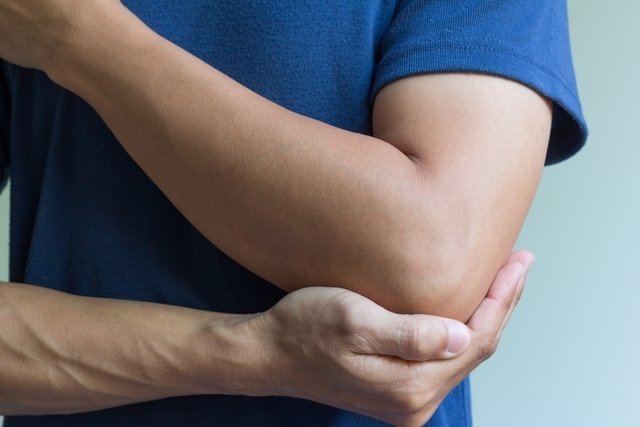Joint pain is usually not a sign of a serious problem and can be treated at home by applying hot compresses to the affected areas. However, joint pain with other symptoms, like stiffness, fever or difficulty moving, can also be a sign of a more serious condition, such as arthritis or tendinitis.
Joint pain can be localized to just one area, or felt all over the body. Depending on the underlying cause, diagnosing this discomfort may require a physical assessment, bloodwork and/or image testing.
Joint pain that is very intense, takes more than a month to disappear or causes visible deformity, it is very important to consult a doctor for diagnosis and treatment.

Why do I have joint pain?
The most common causes of joint pain are:
1. Arthritis
Arthritis is the main cause of joint pain and can occur due to excess weight, direct trauma and natural wear and tear on the joint. It can lead to symptoms such as pain, difficulty moving the affected joint and deformity.
What to do: To treat arthritis, physiotherapy and medication may be prescribed by your doctor. More serious cases may require surgery. Treatment may vary from patient to patient, however, which is why the doctor may order further testing to determine the type of arthritis present.
Also recommended: Arthritis Diet : What to Eat & Avoid (with 3-Day Meal Plan) tuasaude.com/en/arthritis-diet2. Gout
Gout is an inflammatory disease caused by excess uric acid in the blood. It ends up accumulating in the joints and leads to symptoms such as joint pain, swelling and local redness. Uric acid often builds-up in the big toe, leading to pain when walking or placing your foot on the ground.
What to do: Be sure to consult a rheumatologist or general practitioner to start treatment to relieve symptoms. Gout medicine your doctor may prescribe includes anti-inflammatories and medication that helps to reduce uric acid levels.
3. Tendinitis
Tendinitis is characterized by tendon inflammation. Tendons are a structure that connects muscles to bones, and inflammation of the tendon can lead to pain, difficulty moving the affected limb, swelling and local redness. Tendinitis is most often related to repetitive movements.
What to do: It is important to rest the affected area to prevent worsening of inflammation and symptoms., Analgesic and anti-inflammatory medications can also help to relieve swellin and joint pain, while physiotherapy may be advised to restore mobility.
4. Sprained knee
A knee sprain can cause pain in the knee joint. Abnormal twisting, sudden movements or direct trauma to the knee can lead to excessive stretching of the ligaments, resulting in symptoms such as intense knee pain, swelling and difficulty bending the knee.
What to do: Immobilize and rest the affected knee and apply ice on the area to reduce swelling and inflammation. Check out other ways to relieve knee pain.
Also recommended: 11 Causes of Knee Pain (w/ Remedies & Treatment for Relief) tuasaude.com/en/knee-pain5. Epicondylitis
Epicondylitis is the inflammation of the wrist extensor muscles that is often caused by repetitive strain. Pain is typically felt in the elbow and can radiate to the forearm. This pain worsens when performing movements like opening a door, combing your hair, writing or typing. You may also notice reduced strength in the arm or wrist, which can make holding a glass, for example, difficult.
What to do: In these cases, you are advised to stop the performing repetitive movements that triggered the condition. and to undergo physiotherapy to relieve pain. Additionally, medication may be prescribe to relieve pain and reduce inflammation. In more severe cases, surgery may be recommended.
6. Bursitis
Bursitis is characterized by inflammation of the synovial bursa (a fluid-filled sac) located inside the shoulder joint. The sac serves to reduce friction between bones, ligaments and muscles, and inflammation may lead to weakness throughout the affected arm, a tingling sensation and difficulty in lifting the arm above the head.
What to do: Bursitis treatment typically involves physiotherapy to prevent joint stiffening and maintain movement. The doctor may prescribe anti-inflammatory medications for around 7 to 14 days, as needed.
7. Rheumatoid arthritis
Rheumatoid arthritis is a chronic autoimmune and inflammatory disease that occurs when the immune system attacks the body and joints. It leads to swelling and inflammation of the joints, as well as difficulty moving joints, decreased local strength and pain that is worse immediately after waking up.
What to do: It is important to adhere to treatment as prescribed by a rheumatologist. It usually involves the use of medication to relieve pain and reduce swelling. It is important to undergo physiotherapy to reduce stiffness and promote optimal functioning.
8. Infection
Infection with the viruses that cause dengue, Zika and Chikungunya can lead to inflammation of various joints in the body, resulting in joint pain throughout the body. Other symptoms may also appear depending on the virus, such as fever, tiredness, pain around the eyes, loss of appetite and malaise.
What to do: If these infections are suspected, do not take over-the-counter medications and proceed immediately to the nearest emergency room. The treatment normally prescribed by the doctor consists of rest, hydration and medications that help relieve symptoms. However, if, your symptoms do not improve or worsen even with treatment, it is important to return to the hospital for further testing.

How to treat
When joint pain lasts for over 7 days, you may need to take medication such as analgesics or anti-inflammatories, as prescribed by a doctor. Topical ointments such as diclofenac can also help relieve pain and promote movement, however, you should see a doctor for assessment before starting treatment
You can apply a cold compress on the joint to relieve symptoms, however longterm functioning is best preserved through physiotherapy sessions, completed at least 3 times a week. Low-impact exercise, such as Pilates or water aerobics, may also be beneficial.
How to prevent
To prevent joint pain, you should exercise regularly, performing low-impact exercises, such as walking, cycling or swimming. Maintaining an ideal weight, especially after the age of 50, may also be beneficial, as well as a diet rich in fish and seafood, as these contain substances that help promote joint health and reduce inflammation.
